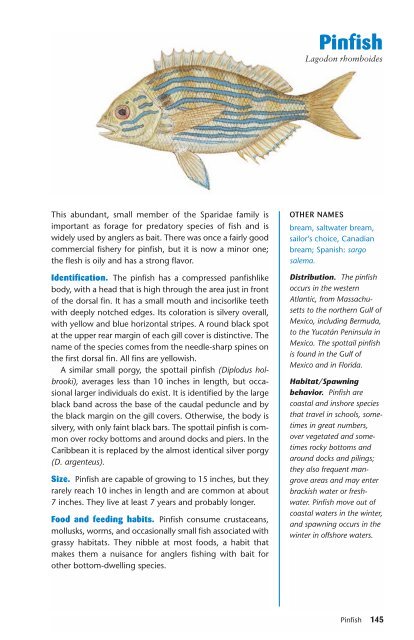Ken Schultz's Field Guide to Saltwater Fish - Macaw Pets store
Ken Schultz's Field Guide to Saltwater Fish - Macaw Pets store
Ken Schultz's Field Guide to Saltwater Fish - Macaw Pets store
You also want an ePaper? Increase the reach of your titles
YUMPU automatically turns print PDFs into web optimized ePapers that Google loves.
This abundant, small member of the Sparidae family is<br />
important as forage for preda<strong>to</strong>ry species of fish and is<br />
widely used by anglers as bait. There was once a fairly good<br />
commercial fishery for pinfish, but it is now a minor one;<br />
the flesh is oily and has a strong flavor.<br />
Identification. The pinfish has a compressed panfishlike<br />
body, with a head that is high through the area just in front<br />
of the dorsal fin. It has a small mouth and incisorlike teeth<br />
with deeply notched edges. Its coloration is silvery overall,<br />
with yellow and blue horizontal stripes. A round black spot<br />
at the upper rear margin of each gill cover is distinctive. The<br />
name of the species comes from the needle-sharp spines on<br />
the first dorsal fin. All fins are yellowish.<br />
A similar small porgy, the spottail pinfish (Diplodus holbrooki),<br />
averages less than 10 inches in length, but occasional<br />
larger individuals do exist. It is identified by the large<br />
black band across the base of the caudal peduncle and by<br />
the black margin on the gill covers. Otherwise, the body is<br />
silvery, with only faint black bars. The spottail pinfish is common<br />
over rocky bot<strong>to</strong>ms and around docks and piers. In the<br />
Caribbean it is replaced by the almost identical silver porgy<br />
(D. argenteus).<br />
Size. Pinfish are capable of growing <strong>to</strong> 15 inches, but they<br />
rarely reach 10 inches in length and are common at about<br />
7 inches. They live at least 7 years and probably longer.<br />
Food and feeding habits. Pinfish consume crustaceans,<br />
mollusks, worms, and occasionally small fish associated with<br />
grassy habitats. They nibble at most foods, a habit that<br />
makes them a nuisance for anglers fishing with bait for<br />
other bot<strong>to</strong>m-dwelling species.<br />
Pinfish<br />
Lagodon rhomboides<br />
OTHER NAMES<br />
bream, saltwater bream,<br />
sailor’s choice, Canadian<br />
bream; Spanish: sargo<br />
salema.<br />
Distribution. The pinfish<br />
occurs in the western<br />
Atlantic, from Massachusetts<br />
<strong>to</strong> the northern Gulf of<br />
Mexico, including Bermuda,<br />
<strong>to</strong> the Yucatán Peninsula in<br />
Mexico. The spottail pinfish<br />
is found in the Gulf of<br />
Mexico and in Florida.<br />
Habitat/Spawning<br />
behavior. Pinfish are<br />
coastal and inshore species<br />
that travel in schools, sometimes<br />
in great numbers,<br />
over vegetated and sometimes<br />
rocky bot<strong>to</strong>ms and<br />
around docks and pilings;<br />
they also frequent mangrove<br />
areas and may enter<br />
brackish water or freshwater.<br />
Pinfish move out of<br />
coastal waters in the winter,<br />
and spawning occurs in the<br />
winter in offshore waters.<br />
Pinfish 145


